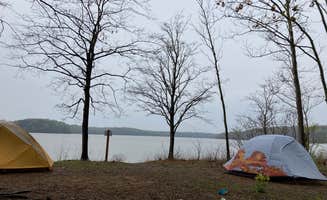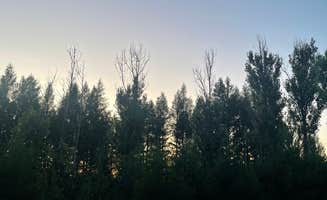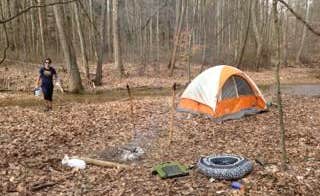Hoosier National Forest offers multiple dispersed camping options throughout its heavily forested terrain, characterized by limestone ridges and valleys. Elevations range from 400 to 900 feet with seasonal temperature swings from below freezing in winter to 90°F+ in summer. Camping sites range from roadside pull-offs to secluded hike-in locations, with most featuring natural clearings rather than developed pads.
What to do
Hiking trails access: Peninsula Trail offers designated backcountry sites accessible via moderate hiking paths. "The Peninsula Trail and Grub Ridge trails both have marked campsites that are very far apart and totally private. These are dispersed/primitive sites with a fire ring only," notes a camper at Peninsula Trail.
Wildlife observation: Early mornings provide opportunities to spot deer, foxes, and various bird species. "Watch for timber rattlesnakes. My dogs and I got loads of ticks in April 2020 from Leota to Spurgeon Hollow," warns a hiker at Knobstone Trail. Bring binoculars for better viewing.
Stargazing: Light pollution levels remain low at most sites. "Light pollution is pretty low however, so good stargazing," reports a visitor to Peninsula Trail. Plan visits during new moon phases for optimal viewing conditions.
Water activities: Some sites offer access to nearby lakes. "At the pond there was a pad of concrete leftover from who knows what," mentions a camper at Sundance Lake Dispersed Camping, indicating possible boat or fishing access points.
What campers like
Complete solitude: Most dispersed sites provide significant privacy. "Multiple campsites in the area, I've stayed at two both of which were away from others, clean, fairly flat and had plenty of dead wood around to burn," shares a visitor to Berry Ridge Road - Dispersed Camping.
Natural camping experience: Free camping near Hoosier National Forest offers a genuine wilderness feel. "For those of you who don't understand disperse camping this is the perfect site for a tent to camp without anything but what you bring in and take out," explains a camper at Berry Ridge Road.
Accessible primitive sites: Many sites balance remoteness with accessibility. "Beautiful secluded site that is pretty far off of the road, but not too far. There was no traffic or other people in site. I have a promaster conversion and had no trouble making it to this site, however the road was gravel and steep at times," describes another Berry Ridge Road camper.
Trail connections: Several sites connect directly to hiking paths. "There's parking after a decrepit gravel road and suitable for camping. There are campsites along the trail just have to find them," notes a visitor to Jackson Trailhead.
What you should know
True primitive conditions: Most dispersed sites lack all facilities. "This is NOT a campground, but just roadside pull-offs on public land. There are no restrooms, fire rings, picnic tables, or other amenities," explains a visitor to Mitchell Creek Road Dispersed.
Vehicle limitations: Access varies significantly between sites. "I would not be trying to pull a travel trailer back into here unless it was very small," warns a camper about Sundance Lake Dispersed Camping.
Navigation challenges: Cell service remains unreliable in many areas. "Have a paper map handy, as there is no cell signal and GPS was spotty," advises a Mitchell Creek Road camper.
Wildlife awareness: Active wildlife populations require proper food storage. "I would hear rustling in the leaves, I assumed it was a pack of cayotes and they would leave once I started banging on stuff and primally yelling," recounts a solo camper at Berry Ridge Road.
Tips for camping with families
Site selection priorities: Choose spots with flat terrain for easier tent setup. "Good spot to get some quiet time to learn/hone skills or for some good quality time with the family while being plugged into nature and unplugged from their electronics," suggests a visitor to Hickory Ridge.
Water planning: No reliable water sources exist at most sites. "Long walk to the water so make sure you bring plenty of drinking water. Springs available in the valleys but watch for timber rattlesnakes," advises a Peninsula Trail camper.
Safety preparations: Consider noise-making devices for wildlife encounters. "Solo camped here with my dogs. First time I've ever been camping but this spot was really cool. Clean. Secluded and peaceful," shares a Berry Ridge Road visitor.
Tips from RVers
Size restrictions: Most dispersed sites accommodate only small vehicles. "Some sites, at least one, could fit a pretty good sized camper. This is pack in pack out, no amenities camping for free," notes a Berry Ridge Road visitor about free camping near Hoosier National Forest.
Turn-around space: Limited maneuvering room exists at many sites. "I did not see any pull offs that would accommodate an RV of any size, and nothing large enough to turn a trailer around. One pull off was nearly too small to turn around my small pick up truck," cautions a Mitchell Creek Road camper.
Road conditions: Unpaved access roads may challenge larger vehicles. "I have a promaster conversion and had no trouble making it to this site, however the road was gravel and steep at times," reports a Berry Ridge Road camper about road quality.




